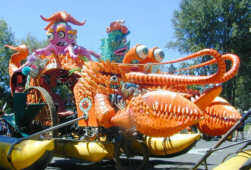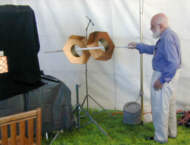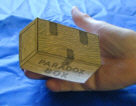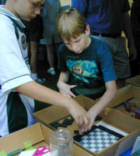"There is no difference between 'green' and 'orange'" says Joe.

"There is an obvious difference between 'green' and 'orange'" says Mary.
Click on the picture to see (or not see) the difference.
.

|
Science is not what it seems at first glance: more looking is required. (In
physics, a quantum jump is the
smallest change physically possible.) .
Science is more subtle than familiar
stuff, and "seeing" it requires a little hard work.
(A
parameter is a mathematically
.
defined constant or variable.) The subtlties of science are often undeniable in unfamiliar ways. (Energy
cannot be defined as the capacity
.
for doing work for the same reasons that a vegetable cannot be defined as a potato.) Wishful thinking tends to encourage us to stop looking once we've found what we like: that leads to self- deception. (Science
succeeds because it seeks the whole truth.
And advertising, by far our greatest source of influential information, succeeds because it avoids the truth, the whole truth, and nothing but the truth.) |
But almost everyone sees quantum jump as a very large change. And "Quantum Leap" became a popular TV sitcom.
|
|
Science is hard, but rewarding, work. Science sees certain logical necessities. Science sees self-decepton and tries hard to sidestep it. |
| "Pseudoscience"is
belief in a lot of things that today's science knows to be wrong or at
the very best extremely improbable.
But seeing the errors that science has seen requires "perceptions" that need to be carefully developed, something that education is just beginning to understand how to do. Education also has to fight a cultural tendency to "dumb down," to affect an anti-intellectual attitude that encourages everyone to avoid the hard work that can lead us to scientific literacy and hi-tech competence. Education has to fight the publication of incompetent textbooks. In studies of K-12 science textbooks by the most competent reviewers (Feynman in the 60's and John Hubisz in May, 2003) ALL of the textbooks were found to be unscientific. Almost NO concept from our knowledge starting with about Galileo was presented correctly. Rather, the pre-scientific misconceptions prevailed.
|
Only
rarely is the breadth and depth of this problem recognized.
Not by the general public. Not by the teachers in the public schools.
Not by the media of communication that disseminate knowledge. Not
even by much of the skeptic movement. The state of those textbooks
is telling us something and almost noone is listening.
Science (including math) is different. The teachers and students using those texts are not seeing the difference between pre-scientific knowlege and the real science of today. The textbook authors didn't either, and neither does most of the rest of the world. Furthermore, the textbooks do not improve. Year after year, decade after decade, the errors remain intact, and public knowledge of science remains unchanged and unscientific. Hubisz noted that time has brought not improvement, but just "dumbing-down" of the books. (In an earlier study, Hubisz noted that high school texts had improved accuracy–but with "dumbed-down language"–compared with earlier years.) |
Oregonians for Rationality
O4R

.2001 
2002 
.2003 
CLICK ON THE BUTTON |

Da Vinci Days O4R booth
|
 |
 |
 |
Illusions
 |
|
Vampire
Mirror
|
 |
...Magic
..2000... 2002
|
 |
How
do our eyes fool us?
How do our ears fool us? How do others fool us? How do we fool ourselves? |
| Puzzles | |||
 |
 |
 2003 2003 |
What's new? |
Puzzles
and posters from Knowledge for Use have
potential
for counteracting pseudoscience.
|
|
|
|
Ratio and proportion,
Newton's Laws of Motion–which were the gateway to modern science and which seem to be a locked gate to so many modern students of science–require good insight into the first two. The first two Laws of Motion are about velocity and acceleration, and Newton invented calculus to do calculations with these two measurable quantities. Velocity is the time rate change of position and acceleration is the time rate change of velocity. Both of these "deravitives" are the extrapolation to a limit of a ratio. The first brick wall of math the young and developing intellect hits in grade school is fractions; that is, ratios. Many never quite get over that wall, and surprisingly few grow up to become adults who can solve simple problems of proportional distribution or of conversion of units. The development of Newton's laws into a theory useful for making things happen the ways we want requires pretty good reasoning with the tools of the above list. American schools have, especially in the past few decades, developed not good formal operational reasoning but rather a culture of anti-intellectualism. Dumbing-down is a virtue in the eyes of many. Those intellectual developments appear most easily between about fourth or fifth grade up through high school and early college. Because scientific concepts are much more powerful than pre-scientific ideas, the difference between understanding and not understanding is extreme. And dumbing down in high school sets up future adults that will easily get kicked into the gutter for the dumb by the juggernaut of a high-tech society based on the discoveries of scientific thinking.Furthermore, modern science, especially modern physics, is human knowledge of the simplest things. Social interations are far more demanding of our understanding of multiple-parameter interactions. It's easy to discover the clarity with which a person recognizes such relationships. The 25 years of "Mathematical Games" by Martin Gardner in Scientific American gave us a lot of such discoveries. They were a road, a veritable superhighway, to discovery. (Or should that be "virtual superhighway.") Discover
the Unexpected!
|